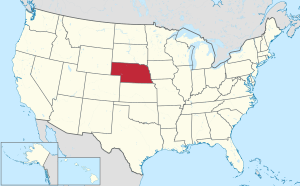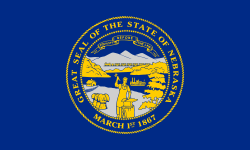Nebraska | |
|---|---|
| Nickname: The Cornhusker State | |
| Motto: | |
| Anthem: "Beautiful Nebraska" | |
 Map of the United States with Nebraska highlighted | |
| Country | United States |
| Before statehood | Nebraska Territory |
| Admitted to the Union | March 1, 1867 (37th) |
| Capital | Lincoln |
| Largest city | Omaha |
| Largest county or equivalent | Douglas |
| Largest metro and urban areas | Omaha–Council Bluffs |
| Government | |
| • Governor | Jim Pillen (R) |
| • Lieutenant governor | Joe Kelly (R) |
| Legislature | Nebraska Legislature |
| Judiciary | Nebraska Supreme Court |
| U.S. senators | Deb Fischer (R) Pete Ricketts (R) |
| U.S. House delegation | 1: Mike Flood (R) 2: Don Bacon (R) 3: Adrian Smith (R) (list) |
| Area | |
• Total | 77,327[1] sq mi (200,356 km2) |
| • Land | 76,796[1] sq mi (199,099 km2) |
| • Water | 531[1] sq mi (1,247 km2) 0.7% |
| • Rank | 16th |
| Dimensions | |
| • Length | 430 mi (690 km) |
| • Width | 210 mi (340 km) |
| Elevation | 2,600 ft (790 m) |
| Highest elevation | 5,424 ft (1,654 m) |
| Lowest elevation | 840 ft (256 m) |
| Population (2020) | |
• Total | 1,961,504[3] |
| • Rank | 38th |
| • Density | 24.94/sq mi (9.62/km2) |
| • Rank | 43rd |
| • Median household income | $59,970[4] |
| • Income rank | 25th |
| Demonym | Nebraskan |
| Language | |
| • Official language | English[5][6] |
| Time zones | |
| most of state | UTC−06:00 (Central) |
| • Summer (DST) | UTC−05:00 (CDT) |
| Panhandle | UTC−07:00 (Mountain) |
| • Summer (DST) | UTC−06:00 (MDT) |
| USPS abbreviation | NE |
| ISO 3166 code | US-NE |
| Traditional abbreviation | Neb., Nebr. |
| Latitude | 40° N to 43° N |
| Longitude | 95° 19′ W to 104° 03′ W |
| Website | nebraska |
| List of state symbols | |
|---|---|
 | |
 | |
| Slogan | Welcome to NEBRASKAland where the West begins[7]
 |
| Living insignia | |
| Bird | Western meadowlark[8] |
| Fish | Channel catfish |
| Flower | Tall Goldenrod[9] |
| Grass | Little bluestem[10] |
| Insect | Western honey bee[11] |
| Mammal | White-tailed deer[12] |
| Tree | Eastern Cottonwood[13] |
| Inanimate insignia | |
| Beverage | Milk Soft drink: Kool-aid |
| Dance | Square dance |
| Fossil | Mammoth[14] |
| Gemstone | Blue agate[15] |
| Rock | Prairie agate[16] |
| River | Platte River |
| Soil | Holdrege series |
| State route marker | |
 | |
| Lists of United States state symbols | |
Nebraska (/nəˈbræskə/ nə-BRASS-kə)[17] is a landlocked state in the Midwestern region of the United States. It borders South Dakota to the north; Iowa to the east and Missouri to the southeast, both across the Missouri River; Kansas to the south; Colorado to the southwest; and Wyoming to the west. Nebraska is the 16th-largest state by land area, with just over 77,220 square miles (200,000 km2). With a population of over 1.9 million, it is the 38th-most populous state and the eighth-least densely populated. Its capital is Lincoln, and its most populous city is Omaha, which is on the Missouri River. Nebraska was admitted into the United States in 1867, two years after the end of the American Civil War. The Nebraska Legislature is unlike any other American legislature in that it is unicameral, and its members are elected without any official reference to political party affiliation. Nebraska is one of only two states that divide electoral college votes by district, and is not winner-take-all.[18]
Nebraska is composed of two major land regions: the Dissected Till Plains and the Great Plains. The Dissected Till Plains region consists of gently rolling hills and contains the state's largest cities, Omaha and Lincoln. The Great Plains region, occupying most of western Nebraska, is characterized by treeless prairie. Eastern Nebraska has a humid continental climate while western Nebraska is primarily semi-arid. The state has wide variations between winter and summer temperatures; the variations decrease in southern Nebraska. Violent thunderstorms and tornadoes occur primarily during spring and summer, and sometimes in autumn. The Chinook wind tends to warm the state significantly in the winter and early spring.
Indigenous peoples, including Omaha, Missouria, Ponca, Pawnee, Otoe, and various branches of the Lakota (Sioux) tribes, lived in the region for thousands of years before European discovery and exploration. The state is crossed by many historic trails, including that of the Lewis and Clark Expedition. The completion of the Transcontinental Railroad through Nebraska and passage of the Homestead Acts led to rapid growth in the population of American settlers in the 1870s and 1880s and the development of a large agriculture sector for which the state is known to this day.
- ^ a b c "Explore Census Data". data.census.gov. Archived from the original on February 5, 2024. Retrieved February 5, 2024.
- ^ a b "Elevations and Distances in the United States". United States Geological Survey. 2001. Archived from the original on October 15, 2011. Retrieved October 24, 2011.
- ^ "Quickfacts. Nebraska". census.gov. Archived from the original on November 11, 2022. Retrieved April 25, 2023.
- ^ "Median Annual Household Income". The Henry J. Kaiser Family Foundation. Archived from the original on December 20, 2016. Retrieved December 9, 2016.
- ^ Neb. Const. art. I, sec. 27 Archived November 18, 2022, at the Wayback Machine (1920)
- ^ Porter, Rosalie Pedalino (1996). Forked Tongue: The Politics of Bilingual Education (2nd ed.). New Brunswick, N.J.: Transaction Publishers. p. 211. ISBN 1-351-51952-2. OCLC 1007231949. Archived from the original on April 15, 2023. Retrieved March 19, 2023.
- ^ "Nebraska Legislature statute 90-105". nebraskalegislature.gov. Archived from the original on September 4, 2017. Retrieved September 4, 2017.
- ^ "Nebraska Legislature statute 90-107". nebraskalegislature.gov. Archived from the original on February 21, 2019. Retrieved February 20, 2019.
- ^ "Nebraska Legislature statute 1-101". nebraskalegislature.gov. Archived from the original on February 21, 2019. Retrieved February 20, 2019.
- ^ "Nebraska Legislature statute 90-112". nebraskalegislature.gov. Archived from the original on February 21, 2019. Retrieved February 20, 2019.
- ^ "Nebraska Legislature statute 90-114". nebraskalegislature.gov. Archived from the original on February 21, 2019. Retrieved February 20, 2019.
- ^ "Nebraska Legislature statute 90-117". nebraskalegislature.gov. Archived from the original on February 21, 2019. Retrieved February 20, 2019.
- ^ "Nebraska Legislature statute 90-113". nebraskalegislature.gov. Archived from the original on February 21, 2019. Retrieved February 20, 2019.
- ^ "Nebraska Legislature statute 90-109". nebraskalegislature.gov. Archived from the original on February 21, 2019. Retrieved February 20, 2019.
- ^ "Nebraska Legislature statute 90-108". nebraskalegislature.gov. Archived from the original on February 21, 2019. Retrieved February 20, 2019.
- ^ "Nebraska Legislature statute 90-110". nebraskalegislature.gov. Archived from the original on February 21, 2019. Retrieved February 20, 2019.
- ^ "Nebraska". Merriam-Webster.com Dictionary. Merriam-Webster.
- ^ "Distribution of Electoral Votes". National Archives. September 19, 2019. Retrieved September 17, 2024.
Cite error: There are <ref group=lower-alpha> tags or {{efn}} templates on this page, but the references will not show without a {{reflist|group=lower-alpha}} template or {{notelist}} template (see the help page).

